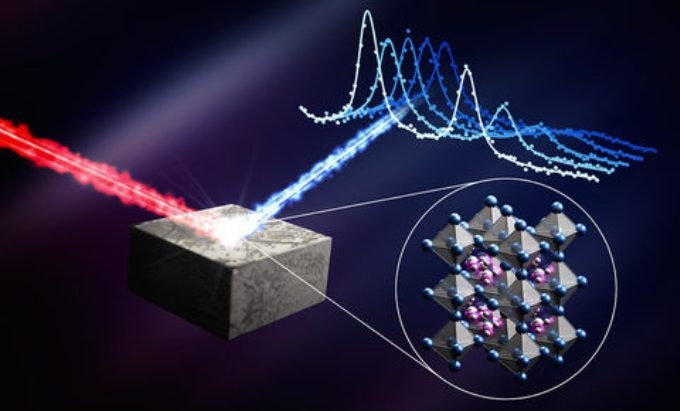Aug 12 2019
Solar energy products are taken over by silicon as it is less expensive, stable, and more effective at converting sunlight into electricity. Any new material should compete, and win, on those bases in order to challenge silicon.
 Perovskite materials are gaining popularity in the photovoltaic world due to their high efficiency and low cost. Light excites electrons in the material that can then flow as electricity. “Dancing atoms in perovskite materials provide insight into how solar cells work” by SLAC National Accelerator Laboratory is licensed under CC BY-NC-SA 2.0. (Image credit: OIST)
Perovskite materials are gaining popularity in the photovoltaic world due to their high efficiency and low cost. Light excites electrons in the material that can then flow as electricity. “Dancing atoms in perovskite materials provide insight into how solar cells work” by SLAC National Accelerator Laboratory is licensed under CC BY-NC-SA 2.0. (Image credit: OIST)
An international research partnership between Shanghai Jiao Tong University, the Ecole Polytechnique Fédérale de Lausanne (EPFL), and the Okinawa Institute of Science and Technology Graduate University (OIST) has helped identify a stable material that more effectively produces electricity, thereby challenging the domination of silicon.
The collaborating groups have reported in Science how the material CsPbI3 has been stabilized in a new configuration that can achieve high conversion efficiencies.
CsPbI3 is an inorganic perovskite, a class of materials turning more popular in the solar world because of their low cost and high efficiency. This configuration is remarkable since stabilizing these materials has been an issue from the past.
We are pleased with results suggesting that CsPbI3 can compete with industry-leading materials. From this preliminary result we will now work on boosting the material’s stability—and commercial prospects.
Professor Yabing Qi, Head, Energy Materials and Surface Sciences Unit, OIST
Qi also led the surface science aspect of the research.
Energy Level Alignment
CsPbI3 is usually investigated in its alpha phase, an established arrangement of the crystal structure suitably referred to as the dark phase due to its black color. This phase is specifically excellent at absorbing sunlight. Unfortunately, it is also unstable—and the structure quickly decomposes into a yellowish form, with lesser potential to absorb sunlight.
Alternatively, this research investigated the crystal in its beta phase, a less established configuration of the structure that is more stable when compared to its alpha phase. Although this structure is more stable, it exhibits comparatively low power conversion efficiency.
This low efficiency is partly due to the cracks that usually appear in thin-film solar cells. These cracks cause the loss of electrons into adjacent layers in the solar cell—electrons that cannot flow as electricity any longer. To repair these cracks, the material was treated with a choline iodide solution, where the solution also optimized the interface between layers in the solar cell, called energy level alignment.
Electrons naturally flow to materials with lower potential energy for electrons, so it is important that the adjacent layers’ energy levels are similar to CsPbI3. This synergy between layers results in fewer electrons being lost—and more electricity being generated.
Dr Luis K. Ono, Study Co-Author, Energy Materials and Surface Sciences Unit, OIST
Dr Ono works at Professor Qi’s lab. Ultraviolet photoemission spectroscopy was used by the OIST group, with support from the OIST Technology Development and Innovation Center, to study the energy level alignment between CsPbI3 and the adjacent layers. These data revealed how electrons can subsequently move freely through the various layers, thereby producing electricity.
After the treatment with choline iodide, the results revealed a low loss of electrons to adjacent layers—owing to better energy level alignments between the layers. By healing the cracks that naturally appear, this treatment resulted in a rise in conversion efficiency from 15% to 18%.
Although this increase might appear small, it introduces CsPbI3 into the area of certified efficiency, the competitive values provided by rival solar materials. While this early result holds promise, inorganic perovskite is still in its infancy. In order for CsPbI3 to really compete with silicon, the group will next analyze the three factors that enable silicon’s domination to continue—efficiency, stability, and cost.